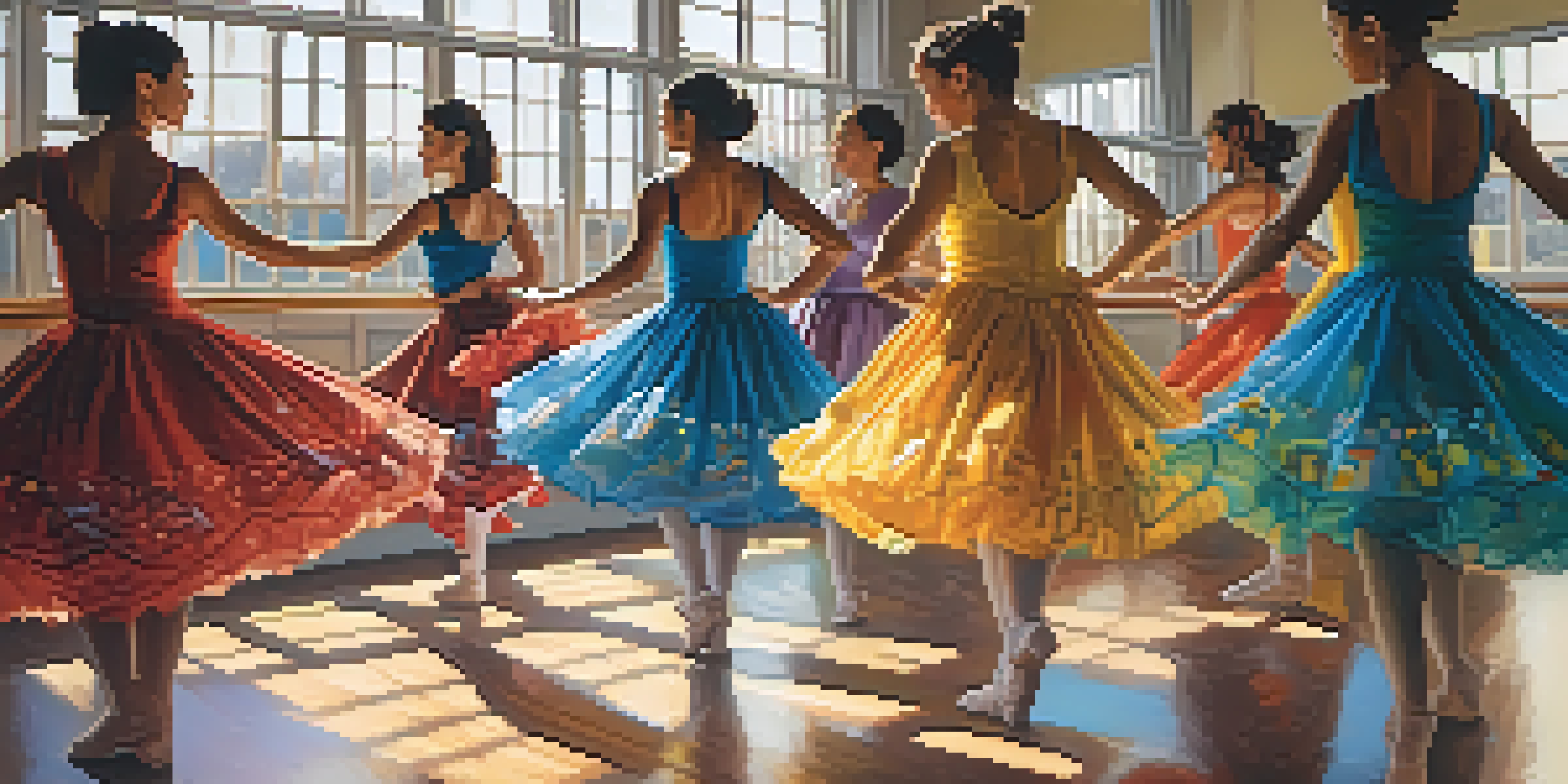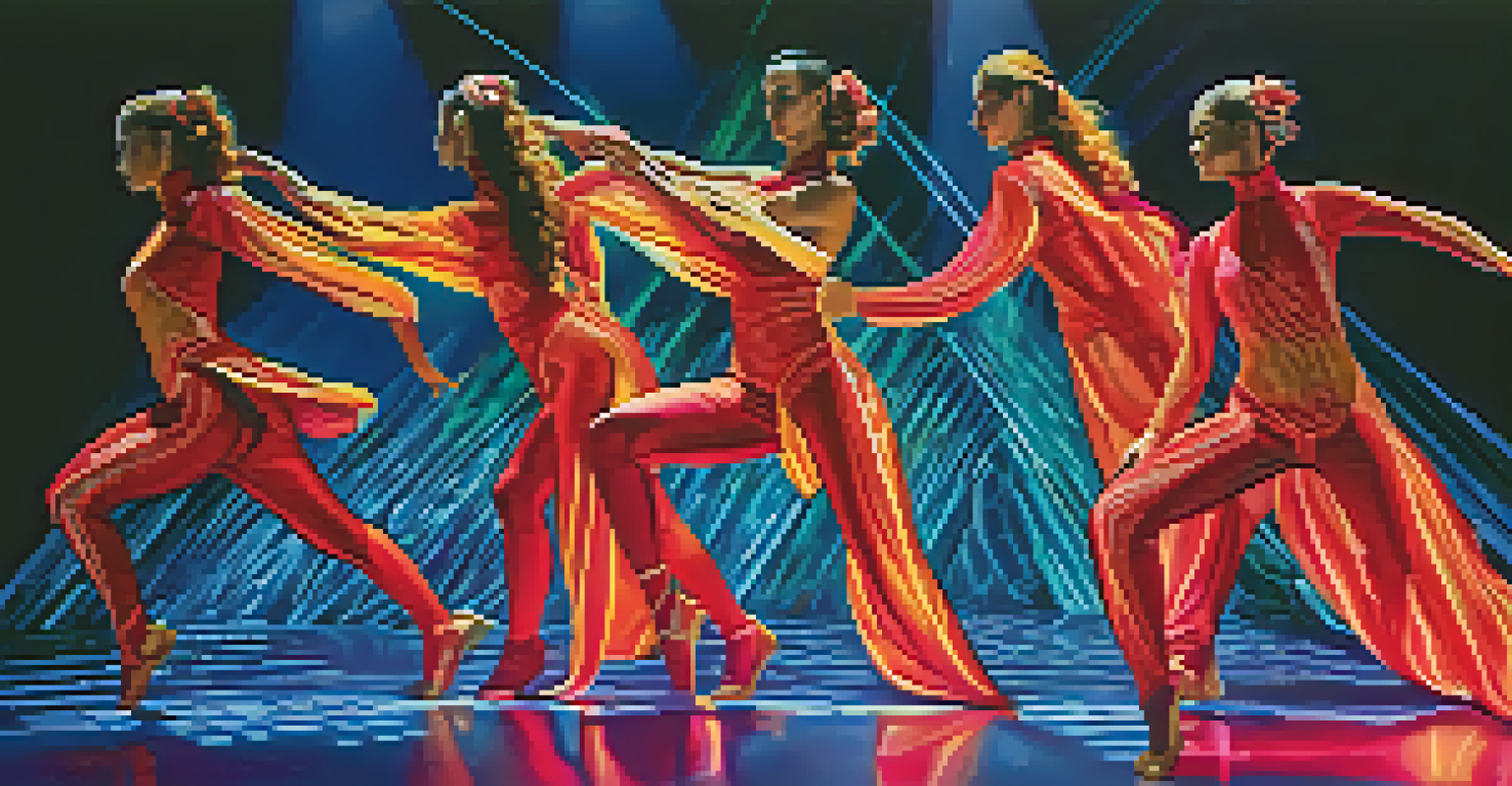Costume Design as an Extension of Character in Dance

The Role of Costume Design in Dance
Costume design serves as a visual language in dance, conveying emotions and narratives without uttering a word. Just as a painter uses colors to evoke feelings, a costume can enhance a dancer's performance by reflecting their character's essence. This visual element not only supports the choreography but also engages the audience, drawing them into the story being told on stage.
Costume design is a powerful tool for storytelling in dance, transforming movement into a visual narrative.
For instance, a flowing gown can symbolize grace and femininity, while a structured outfit might convey strength and power. Each fabric choice, color, and silhouette works together to create a deeper understanding of the character's journey. In this way, costume design becomes an integral part of the storytelling process, underpinning the movement and expression of the dancer.
Moreover, successful costume design collaborates harmoniously with the choreography, allowing for seamless movement. It’s essential for designers to consider how garments will behave during a performance, ensuring they enhance rather than hinder the dancer's ability to express their character. In essence, the costume is not just an accessory; it's a vital component of the dancer's toolkit.
Historical Perspectives on Dance Costumes
Throughout history, dance costumes have evolved alongside cultural and artistic movements, reflecting societal values and trends. In the court dances of the Renaissance, elaborate costumes showcased wealth and status, while 20th-century ballet introduced more minimalist designs to emphasize the dancer's form and technical prowess. This evolution illustrates how costume design adapts to the changing landscape of dance and performance art.

For example, the iconic tutus of classical ballet symbolize a particular era's aesthetic values, aiming to enhance the ballerina's ethereal quality. In contrast, modern dance often favors more functional attire that allows for greater freedom of movement, showcasing the dancer's physicality. This shift demonstrates how costume design can influence not just the appearance of the dancer but also the style of dance itself.
Costumes Enhance Dance Narratives
Costume design acts as a visual language that conveys emotions and character, enriching the storytelling in dance performances.
These historical references remind us that costume design isn't merely about aesthetics; it's also about context. Designers draw inspiration from past eras to create contemporary pieces that resonate with audiences today, bridging the gap between tradition and modernity. This ongoing dialogue between history and innovation in costume design enriches the dance experience for both performers and spectators.
Color Theory and Its Impact on Character
Color plays a significant role in costume design, influencing the audience's emotional response to a character. Different colors evoke various feelings—red can signify passion or anger, while blue often represents calmness or sadness. By thoughtfully selecting colors, designers can craft costumes that resonate with the character's emotional journey, enhancing the storytelling experience.
The relationship between the dancer and the costume is a dance of its own, where collaboration and communication bring characters to life.
For example, consider a performance where a character undergoes a transformation. A costume that transitions from dark shades to bright colors can visually represent this evolution, allowing the audience to connect with the character's internal struggle. This deliberate use of color not only supports the narrative but also adds a layer of complexity to the character's portrayal on stage.
Additionally, cultural connotations of colors vary widely and can add depth to character design. Understanding these nuances allows designers to create costumes that speak universally while still respecting specific cultural contexts. Ultimately, the strategic use of color in costume design enriches the overall dance performance, amplifying emotional engagement for the audience.
Materials and Textiles in Costume Design
The choice of materials and textiles in costume design significantly impacts both aesthetics and functionality. Different fabrics behave uniquely when worn and moved in, influencing how a dancer's performance is perceived. For instance, lightweight fabrics can create an illusion of ethereality, while heavier materials can add presence and weight, shaping the character's identity.
Moreover, the texture of a costume can also convey deeper meanings. A rough, rugged fabric may symbolize struggle or hardship, while smooth, luxurious textiles might suggest comfort or opulence. This tactile quality allows designers to layer additional emotional context into their costumes, enhancing the audience's connection to the characters.
Cultural Context Shapes Costumes
Dance costumes reflect cultural values and traditions, serving as a medium to communicate heritage and identity in performance art.
It's important for designers to balance visual appeal with practicality, ensuring that costumes allow for freedom of movement. A costume can look stunning but will fail to serve its purpose if it restricts the dancer's performance. Thus, selecting the right materials is a crucial step in creating costumes that embody the character while enabling the dancer to fully express their artistry.
Collaboration Between Dancers and Designers
The relationship between dancers and costume designers is a collaborative dance in itself, where open communication leads to successful outcomes. Dancers often have unique insights into how a costume will move and feel during a performance, providing valuable feedback to designers. This partnership ensures that the final product aligns with both the artistic vision and the practical needs of the dancer.
For example, a dancer might suggest specific adjustments to the costume to enhance their range of motion or to better reflect their character's personality. This back-and-forth dialogue can lead to innovative solutions that elevate the overall performance. When dancers feel comfortable and supported by their costumes, their confidence shines through on stage.
Furthermore, involving dancers in the design process fosters a sense of ownership and connection to the character. When performers have a say in their costumes, they can embody their roles more authentically, leading to a richer storytelling experience. Ultimately, this collaborative spirit reinforces the idea that costume design is a shared art form, deeply intertwined with the dance itself.
Cultural Significance of Dance Costumes
Dance costumes often carry profound cultural significance, reflecting traditions, histories, and identities. In many cultures, specific attire plays a crucial role in performance art, symbolizing community values and storytelling. For instance, traditional Indian dance forms use intricate costumes that convey stories from mythology, celebrating heritage and spirituality.
These costumes are not simply decorative; they are imbued with meaning, representing the essence of the culture they originate from. The colors, patterns, and styles can communicate messages about social status, gender roles, and cultural narratives. By understanding these elements, costume designers can create pieces that honor and reflect the cultural contexts in which they are rooted.
Future of Costumes with Technology
The integration of technology in costume design is set to transform performances, offering innovative ways to enhance storytelling and audience engagement.
Moreover, as globalization influences the arts, the blending of various cultural elements in dance costumes has become more prevalent. This fusion can lead to innovative designs that respect tradition while embracing modernity. As a result, dance costumes continue to evolve, serving as a bridge connecting diverse cultural expressions and enriching the dance experience for audiences worldwide.
The Future of Costume Design in Dance
As we look ahead, the future of costume design in dance appears to be an exciting blend of technology and creativity. Innovations such as 3D printing and smart textiles are opening up new possibilities for designers. These advancements allow for experimentation with styles and structures that were previously unimaginable, pushing the boundaries of how costumes can enhance storytelling.
For instance, costumes that change color or texture in response to the dancer's movements could create dynamic visual effects that captivate audiences. This merging of technology and art can lead to immersive experiences that heighten emotional engagement in performances. Such innovative designs can transform traditional narratives into interactive experiences, inviting audiences to participate in the story.

However, while technology offers new opportunities, the essence of costume design will always remain rooted in its ability to express character and emotion. The challenge for designers will be to balance these advancements with the artistry and craftsmanship that define the field. Ultimately, the future of costume design in dance promises to be both a celebration of tradition and an exploration of new frontiers.